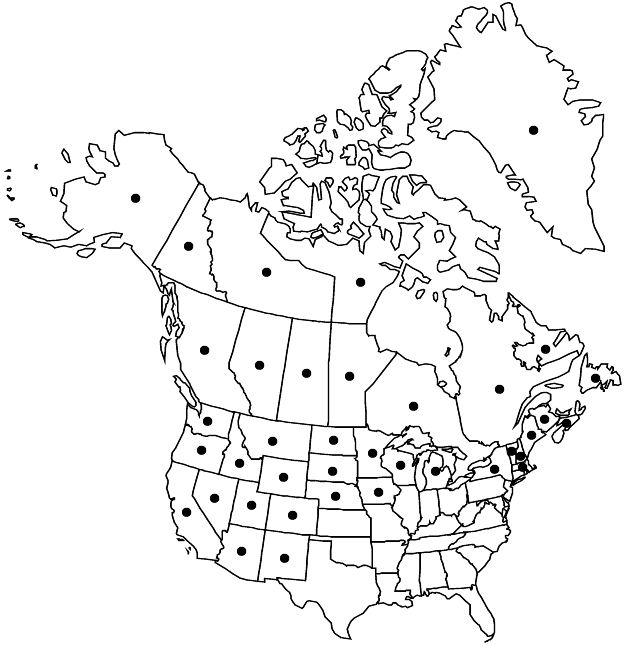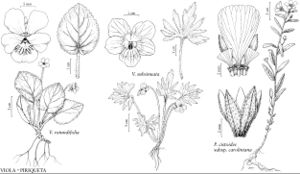Viola adunca var. adunca
Plants erect, decumbent, or prostrate, (4–) 4.5–30 (–35) cm. Basal leaves: blade usually ovate or ovate-deltate, sometimes ± reniform or oblong, 1.3–6.9 × 1.2–5 cm, base cordate, subcordate, truncate, or attenuate, apex acute to obtuse, surfaces glabrous or sparsely to densely puberulent, especially abaxially. Cauline leaves: petiole 0.8–6.5 cm; blade 1.1–5.5 × 1–4.7 cm. Peduncles 3–13.8 cm, bracteoles alternate or opposite. Flowers: sepal margins ciliate or eciliate; lowest petal 9–17 (–23) mm; style head bearded or beardless. Seeds 1.5–2 mm. 2n = 20, 30, 40.
Phenology: Flowering Apr–Aug.
Habitat: Dry to moist meadows, open ground, including lawns, damp banks, openings, meadow edges, rocky areas in coniferous or mixed forests, sandy loam
Elevation: 0–3600 m
Distribution

Greenland, Alta., B.C., Man., N.B., Nfld. and Labr., N.S., N.W.T., Nunavut, Ont., Que., Sask., Yukon, Alaska, Ariz., Calif., Colo., Idaho, Iowa, Maine, Mass., Mich., Minn., Mont., Nebr., Nev., N.H., N.Mex., N.Y., N.Dak., Oreg., S.Dak., Utah, Vt., Wash., Wis., Wyo.
Discussion
Variety adunca can be confused with Viola nephrophylla, which is acaulescent, and with V. labradorica, which lacks decurrent petioles.
H. E. Ballard (1992) noted that eastern specimens of Viola adunca were rarely glabrous, but western ones were often glabrous. Dead, elongated stems often persist on caudices.
J. Clausen (1929) noted that although many American botanists had treated Viola adunca as closely related to or as a variety of V. canina, he thought V. adunca should be treated as a subspecies of the European V. rupestris.
or as a variety of V. canina, he thought V. adunca should be treated as a subspecies of the European V. rupestris.
Variety adunca is the food plant for the larvae of the federally listed Behren’s silverspot butterfly (Speyeria zerene behrensii), Myrtle’s silverspot butterfly (S. z. myrtleae), and Oregon silverspot butterfly (S. z. hippolyta).
Evidence of nectar thievery (presence of holes in the spur) has been observed in populations of var. adunca in California and Colorado. Nectar thievery by bumblebees has been reported in Viola hirta and V. riviniana in Europe (A. J. Beattie 1969b).
Viola cascadensis, from Oregon and adjacent Washington, was described by M. S. Baker (1949b) as having dimorphic growth in which, after chasmogamous flowering, the plant changes from acaulescent to caulescent, forming well-developed, nonpersistent stems with cleistogamous flowers, as well as other differences between it and V. adunca. Viola cascadensis was treated as a variety of V. adunca by C. L. Hitchcock et al. (1955–1969, vol. 3) and was synonymized with V. adunca by H. E. Ballard (1992). Study is needed to determine if recognition of V. cascadensis is warranted.
Selected References
None.
Lower Taxa
"thick" is not a number. "narrow" is not a number.
